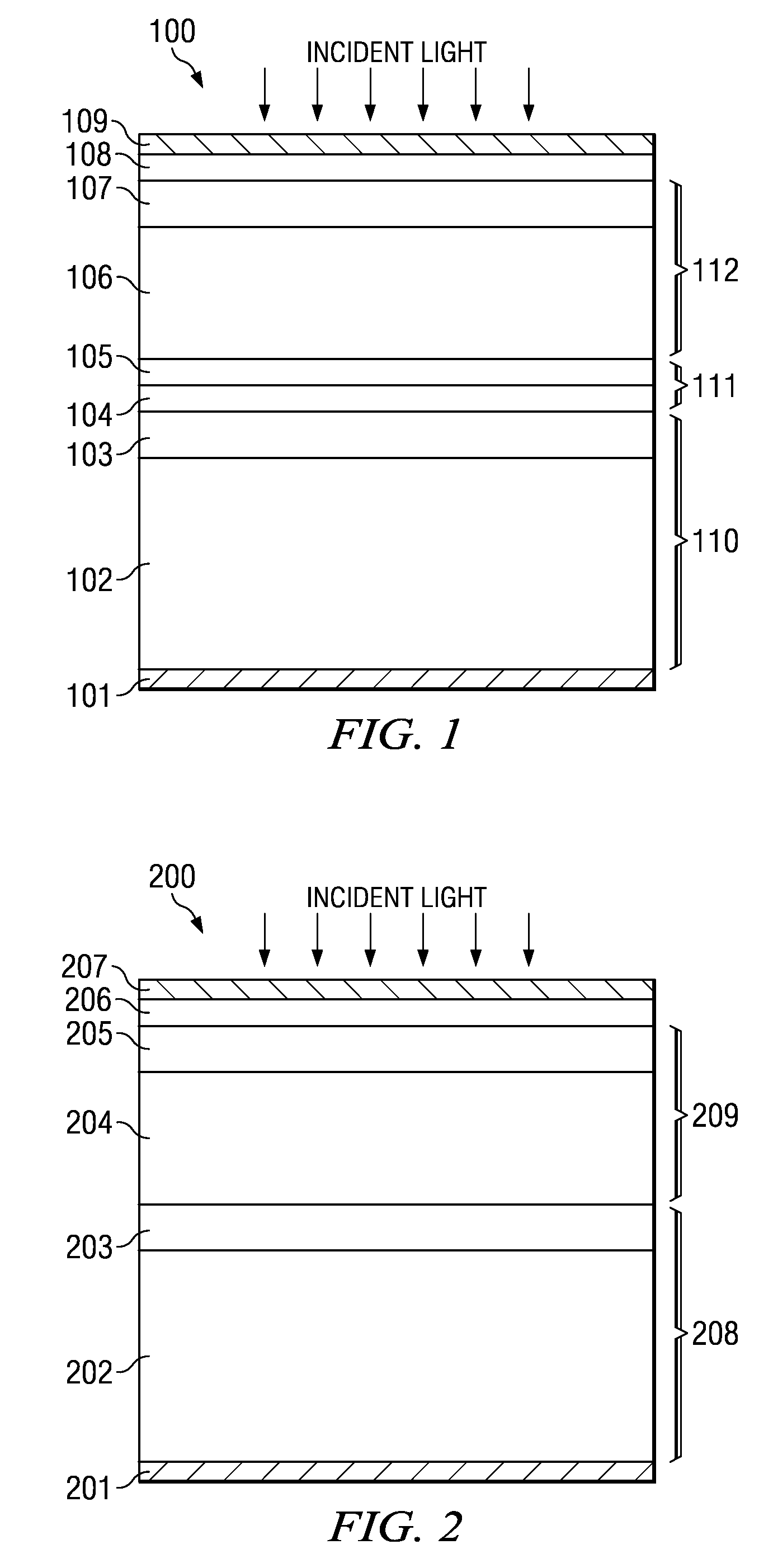High efficiency multijunction ii-vi photovoltaic solar cells
a photovoltaic solar cell, multi-junction technology, applied in photovoltaics, electrical equipment, semiconductor devices, etc., can solve the problems of large heat generation from excess energy of hot carriers, low output current, and relatively low photovoltage, so as to prevent damage
- Summary
- Abstract
- Description
- Claims
- Application Information
AI Technical Summary
Benefits of technology
Problems solved by technology
Method used
Image
Examples
first embodiment
[0047]In this first embodiment of the invention, the material system that is used for the first tunnel junction 111 is not limited to ZnTe semiconductors, but can be made from other relatively high energy gap materials such as CdS (EgCdS≈2.46 eV), ZnSe (EgZnSe≈2.72 eV), MgTe (EgMgTe≈3.40 eV), ZnS (EgZnS≈3.73 eV), CdZnTe (EgCdZnTe≈1.8 to 2.26 eV), CdMgTe (EgCdMgTe≈1.8 to 3.3 eV), CdMnTe (EgCdMnTe≈1.8 to 2.92 eV), and ZnMnSe (EgZnMnSe≈2.8 to 3.30 eV) compound semiconductors. The energy gaps (EgTJ1B and EgTJ1E) of the first tunnel junction 111 must be greater than those of the first emitter 103 (Eg1E) of the first subcell 110 and the second base 106 (Eg2B) of the second subcell 112. In addition, the (p++) and (n++) tunnel junction with homo-interface (homojunction) can be replaced by a tunnel junction with a hetero-interface (heterojunction) that comprises thin layers semiconductor material having different energy gaps. The first tunnel junction is designed in such a way that the tunne...
second embodiment
[0059]A three-subcell photovoltaic solar cell is schematically illustrated in FIG. 3. This second embodiment encompasses the embodiment shown in FIG. 1 and described above with an additional subcell and preferably a second tunnel junction. The preferred three-subcell photovoltaic solar cell 300 ((n+)ZnO / (n+)Cd1-xZnxTe / (p−)Cd1-xZnxTe / (p++)ZnTe / (n++)ZnTe / (n+)CdTe / (p−)CdTe / (p++)ZnTe / (n++)ZnTe / (n+)Si / (p−)Si where the mole fraction x 0.31) includes a first subcell 314, a second subcell 316 formed over the subcell 314, a third subcell 318 formed over the second subcell 316, a first tunnel junction 315 interposed between subcells 314 and 316, a second tunnel junction 317 disposed between subcells 316 and 318, an antireflection coating 312, formed above the topmost subcell 318 to provide protection against photons with energies higher than the bandgaps of third subcell 318, a front contact 313, and a back contact 301. The third subcell 314, which is disposed immediately adjacent to the seco...
fourth embodiment
[0101]In another variation of the present invention, the (p−) and (n) semiconductor layers of cell 800 are reversed.
[0102]The invention discloses, for the first time, several monolithic multi-subcell photovoltaic solar cells having no Group III-V semiconductors and having ideal overall series efficiencies of at least 45% under concentrated sunlight of approximately 500 suns. These ideal energy conversion efficiencies have not been reported before for solar cells composed of any monatomic or compound semiconductor family or combination of such families or material systems (Groups IV, III-V, or II-VI).
[0103]In summary, several monolithic multi-junction or -subcell photovoltaic solar cells have been described which are fabricated of a combination of Group IV and Group II-VI materials, preferably on silicon substrates. Species, alloys, and thicknesses of successively grown layers can be selected to create solar cells having more than fifty percent ideal overall energy conversion efficie...
PUM
 Login to View More
Login to View More Abstract
Description
Claims
Application Information
 Login to View More
Login to View More - R&D
- Intellectual Property
- Life Sciences
- Materials
- Tech Scout
- Unparalleled Data Quality
- Higher Quality Content
- 60% Fewer Hallucinations
Browse by: Latest US Patents, China's latest patents, Technical Efficacy Thesaurus, Application Domain, Technology Topic, Popular Technical Reports.
© 2025 PatSnap. All rights reserved.Legal|Privacy policy|Modern Slavery Act Transparency Statement|Sitemap|About US| Contact US: help@patsnap.com



